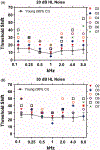Hidden Age-Related Hearing Loss and Hearing Disorders: Current Knowledge and Future Directions
- PMID: 30931204
- PMCID: PMC6436814
- DOI: 10.1080/21695717.2018.1442282
Hidden Age-Related Hearing Loss and Hearing Disorders: Current Knowledge and Future Directions
Abstract
Age-related hearing loss, which affects roughly 35% of those over the age of 70, is the second most common disorder among the elderly. The severity of age related hearing loss may actually be worse if assessments are made under more realistic conditions, such as communicating in noise. Emerging data from humans and animal models suggest that damage to the inner hair cells and/or type I neurons, that relay sound information to the brain may contribute to hearing deficits in a noisy background. Data obtained from carboplatin-treated chinchillas suggest that tone-in-noise thresholds are a sensitive and frequency dependent method of detecting damage to the IHC/type I system. Therefore, tone detection thresholds measured in broadband noise may provide an efficient method of detecting the deficits in specific frequency regions. Preliminary data obtained in elderly subject with normal thresholds in quiet compared to young subjects illustrate the importance of repeating these measurements in broadband noise because thresholds in noise were worse for our elderly subjects than young subjects, even though both groups had similar hearing thresholds in quiet. N-acetyl cysteine supplementation which protects against inner hair cell loss in animal models, may represent a viable therapy for protecting the inner hair cell/type I neurons.
Keywords: Age-related hearing loss; clinical audiogram; hearing disorders; hidden hearing loss; inner hair cells; presbycusis.
Conflict of interest statement
Declaration of Interest: The authors report no conflicts of interest
Figures








References
-
- Sha SH, Taylor R, Forge A, et al. Differential vulnerability of basal and apical hair cells is based on intrinsic susceptibility to free radicals. Hear Res. 2001;155(1–2):1–8. - PubMed
Grants and funding
LinkOut - more resources
Full Text Sources
